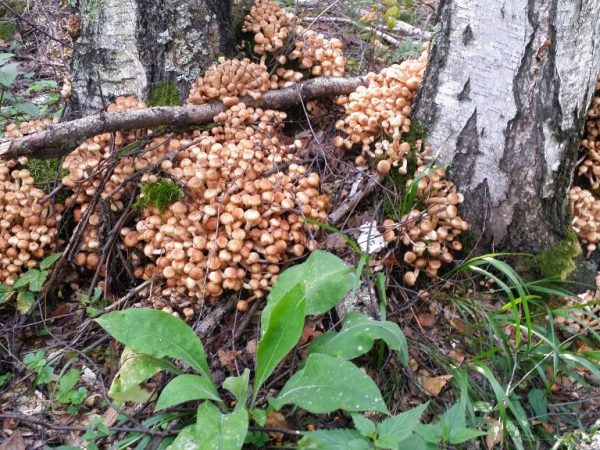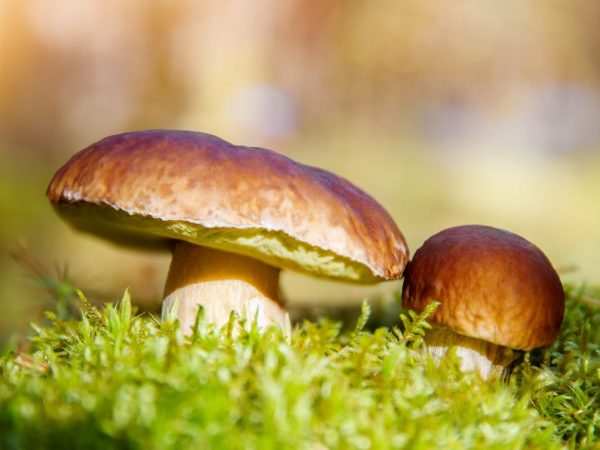What mushrooms grow in the Moscow region in May
The first mushrooms of the Moscow region in May delight with their abundance and variety. They are found in both coniferous and deciduous forests.

Mushrooms of the Moscow Region in May
general characteristics
All types of mushrooms are divided into edible, conditionally edible, inedible and poisonous.
Sometimes for salads or light snacks, May mushrooms collected in the Moscow region are used without heat treatment. For such use, only edible species are suitable, such as champignons and russula.
All edible species are fried, boiled and steamed. They are fragrant and can be processed in any way. Used for first and second courses.
Conditionally edibles have a specific bitter taste. Therefore, housewives do not particularly like to use them in cooking. To get rid of the unpleasant taste, they are soaked and thoroughly washed in running water. Then it is cooked with the addition of spices and only after that the main cooking is started.
Poisonous mushrooms are really dangerous for life and health. Their toxins are difficult to remove, the taste is unpleasant. Special craftsmen can cook fly agarics according to a special recipe (such as Fugo fish). But amateurs should not risk it, because the poison is so toxic that it can cause severe poisoning, leading to death.
Flavor categories
May mushrooms of the Moscow region are divided into 4 flavoring categories:
- Boletus, milk mushrooms, white, mushrooms and fawn, etc., with a strong aroma and bright taste.
- Butterlets, aspen mushrooms, Polish and all kinds of champignons, etc., fragrant, with a mushroom flavor, but it is somewhat weaker than that of the first group.
- Flywheels, honey mushrooms, russula, etc., all specimens with an average taste, less aromatic.
- All conditionally edible species requiring special pre-processing.
For gourmet meals, the first 2 categories are used. Of the 3, snacks and pates are made, and 4 are used more for pickles, to which spices are added to enhance the taste and satisfy the taste buds.
Types of spring mushrooms
After cold winter days, when the earth warms up, mushroom lovers go out on their own kind of "hunt".
Edible species
After the snow melts, on forest glades, on old heaps of leaves and on tender green grass in meadows, "first-borns" grow:
- discina thyroid;
- sclerotinia;
- strobiluriuses;
- petsitsa;
- sarcocyphoid.
They need to be able to cook correctly, they have a strong aroma, and contain a lot of nutrients that a person needs.
Other common mushrooms appear later in the Moscow region in May:
- morels;
- lines;
- podabrikosoviki (garden entoloma);
- oyster mushrooms;
- raincoats;
- honey mushrooms.
In early May, the first boletus and boletus appear. Towards the end of May, the appearance of meadow mushrooms is characteristic of the Moscow region. June begins with the appearance of milk mushrooms.

Boletus appears in early May
Morels are a rare species that prefers to appear in small families in places where there are more deciduous trees and has the following description:
- the surface of the cap consists of cells;
- the leg is white and elongated;
- the color of the cap is light or gray-brown;
- the pulp is brittle, pleasant and narrow.
Characterized by hollowness and pleasant aroma. Fruiting coincides with the flowering of apple trees. It is better to collect morels under poplars and alder.
Following the morels, other May mushrooms appear in the Moscow region - lines, they are not picky about their habitats. More often found in pine forests, can appear in clearings and fires. Sometimes found on stumps, on last year's rotten bark. They have an interesting appearance, with a grayish leg in the grooves. Their hat is huge (19-20 cm), with a fantastic shape, similar to a human brain, all in convolutions and depressions. Its color is brown or ocher. It is better not to eat them raw. They contain toxins that will come out after heat treatment and rinsing.
Irina Selyutina (Biologist):
The presence of the toxic compound gyromitrin is characteristic of the apothecia of the lines, therefore it is strictly forbidden to eat pre-cooked mushrooms for food, because this can lead not only to severe poisoning, but to death. Pre-boiling is recommended for at least 30 minutes in plenty of water. After that, the broth is drained, and the mushrooms are thoroughly washed under running water. However, some of the authors recommend re-boiling, and only after that is it allowed to eat the lines.
However, drying the lines is considered the best option - long-term at elevated temperatures or 6 months in the fresh air. In the case of drying these mushrooms, you can be sure that the gyromitrins leave the fruiting body.
By the way. Since lines and morels are often confused with each other, I recommend boiling morels before cooking for safety reasons.
Pecitsa (Peziza spp) is an interesting species that appears at the end of May in Moscow and the Moscow region. Its fruiting body is red in color, similar to ears or saucers. But they taste like rubber.
Closer to residential areas, near houses, under fruit trees and in orchards, there are thyroid pods or thyroid rosacea. Their fruiting bodies are decorated with blunt-pointed caps of medium size, up to 10-12 cm, which "open" with age. Their edges are curved. They grow up to 13 cm. They have a peculiarity in the aroma, it is mealy and not bright. Therefore, culinary specialists often use this type for pickling or pickling.
May is a great month for raincoats. Under its first rains, their caps grow with great speed, increasing before our eyes. This species prefers deciduous massifs, willow and less often chooses a place for mycosis in spruce forests.
In early May (depending on the weather) honey mushrooms appear and delight their "fans" until the very end of the season, until the first frost.
Poisonous species
Edible mushrooms grow in May in the Moscow region next to their poisonous or inedible counterparts. Which include:
- toadstool is pale;
- poisonous entoloma;
- the pig is thin;
- tinder fungus.
After harvesting the spring harvest, randomly caught poisonous or inedible varieties should be sorted out.
Death cap: it is easy to confuse it with honeycomb. Their caps and shape are similar. The difference is in a thin annular film on the stem.
Irina Selyutina (Biologist):
On a white leg, almost under the cap, a pale toadstool has a ring (the remains of a private bedspread). On the outside (facing the soil), it is often slightly striped, white, but on the inside, it is weakly colored. The ring is wide at first, as if fringed. In older specimens, the ring often disappears.
Toadstool toxins are fatal to humans. It is dangerous to touch it with your hands, because the poisons are absorbed into the skin and transferred into the blood, after which the first symptoms of poisoning appear.
Entoloma poisonous: older specimens appear ashen or brownish. The hat is large, reaching a diameter of up to 25 cm, smooth to the touch in dry weather and slightly sticky after rain. The structure of the flesh is spongy, the leg is thick, with a bend at the bottom.
The pig is thin: outwardly similar to an ordinary pig.But the shape of the cap changes with age and becomes almost flat, with the edges tucked towards the stem in age fungi. The surface is fluffy, like felt, after precipitation begins to stick.
Polypores: their fruiting bodies are perennial and annual. These organisms can be conditionally edible or inedible. They have a scaly cap and a characteristic pulp flavor. To be eaten, it must first be soaked and boiled.
By the way. Inedible tinder fungi can cause in humans:
- an allergic reaction;
- intoxication, accompanied by symptoms typical of mushroom poisoning: vomiting, dizziness and nausea.
Benefit
May forest mushrooms are good for the human body. They contain a lot of fiber, trace elements and vitamins. They are 90% water, low in calories (about 22 kcal per 100 g), used for dietary nutrition.
Fiber in their composition quite fully replaces the product of animal origin - meat. They stabilize blood pressure, blood sugar levels and stimulate brain activity.
They are successfully used by pharmacists to create medicines for various diseases.
Conclusion
Hiking in the forest should only be fun. In order for the walk and harvesting to end safely, you should adhere to safety rules and carefully approach the process of preparing mushroom dishes.



